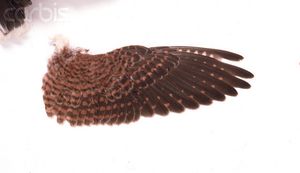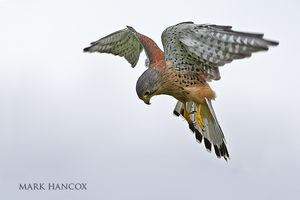Hummingbirds are well known for their ability to hover, as are insects. However, hovering is a much more rare concept in larger animals, such as birds of prey. Birds of prey typically maintain their altitude while hunting by gliding around in circles, in order to generate lift. Kestrels, however, are the only bird of prey capable of hovering. Unlike smaller hummingbirds, kestrels are incapable of beating their wings fast enough to generate enough lift to keep them aloft, so they have to face into the wind and rely on it to provide lift for them. This “windhovering” technique is so precise that their heads stay completely still, a factor that is estimated to increase their hunting efficiency tenfold.
In average wind speed, the kestrel can glide quite comfortably, flapping its wings at an almost leisurely pace. Although the kestrel flaps its wings as if it were flying normally, its forward movement is cancelled out by the wind, keeping it in the same position. The wind catches not only on the wings of the kestrel, but also on its tail. The tail, already broad, is spread out a bit more and depressed, so that it increases the surface area that is exposed to the oncoming wind. The effects of the tail depression are more obvious when the kestrel is preparing to hover.
Before hovering, kestrels tend to glide for a bit and shoot upwards before any hovering actually takes place. During this upward movement, the wings are still outstretched from the gliding, but the tail is tilted downwards. It is thought that this depression of the tail feathers checks the forward momentum, halting the kestrel in midair.
The design of kestrels’ wing feathers is equally important to its ability to hover. Like other birds of prey, kestrels have slotted high lift wings, and these slots help to reduce turbulence while hovering. If the wings didn’t allow air to pass through them, kestrels would not be able to hover, and would keep stalling instead. 
In high winds, the kestrel’s job is easier, and flapping is reduced to a minimum. In even stronger winds, they may not have to flap at all, simply opening their wings and gliding into the wind, a technique called “kiting.”
Although the name “windhovering” suggests the use of wind to hover, some sources claim that kestrels can hover without any wind at all. Their bodies are shaped such that with outstretched wings, kestrels automatically glide forward. This forward movement is cancelled out by rapid wing beats. The downstroke is oriented slightly forwards, like it’s banking before a landing, which pushes the kestrel back in order to negate the forward movement. Hovering without any wind is a lot harder to control, however, and requires a bit of a balancing act. When the kestrel loses its balance, it will often slip forward before regaining control and hovering again. Kestrels will often slip about three times before either moving on or circling around to try again, depending on the possibility of finding prey.
Sources:
http://www.readbookonline.net/readOnLine/23540/
http://www.pauldfrost.co.uk/kestrel.html
